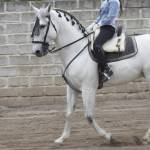Paso Fino Horses and their Gaits

I really enjoyed your article on the Paso Fino horse. The first week in November, I am planning on attending the Paso Fino World Championships that are being held in Tampa, Florida this year to learn more about these fascinating horses. A friend told me that not all Paso Finos are the same, and that there will be some that have different gaits other than the Paso Fino, Paso Corto and Paso Largo you mentioned in the article. Would you please explain the other movements (gaits) so that I will know what I am looking for when I get to the Championships?
I hope you enjoy the World Championships. It should be a fascinating event. Yes, it is true that not all Paso Finos are created equal. In my travels to Colombia, I have come across many of these horses with gaits different from those of the classic Paso Fino. In Colombia, Paso Finos are in fact called “Criollos” and within the Criollo breed there are four different types based on their movement. The most well known is the classic Paso Fino whose gaits are all lateral (the legs on the same side of the body move forward at the same time), and they perform the Paso Fino (fine step), Paso Corte (short step) and Paso Largo (long step). The other Criollo gaits are all diagonal (legs on opposite sides of the body move at the same time) and are the Trote y Galope Reunidos Colombianos, Trocha y Galope Reunidos Colombianos and Trocha Colombiana. Although all Criollos look fairly similar, there are small differences in conformation which predispose a horse to possess the various gaits.
On careful inspection, differences in the angles of the shoulder blades and hips of Criollos can be observed. The Criollo gaits make for incredibly smooth riding. Trying to recognize which gait the horse is doing may be challenging until one learns to differentiate the amount of lift in the knee during the competition and the different sounds of the gaits as the horses hit the sounding board or pista.
The Paso Fino Colombiano is an animated lateral four beat gait (each foot hits the ground at a different time) with a moderate amount of lift in the knees and very fast movement, which make it obviously different from the diagonal gaits. The Trocha Pura Colombiana is a four beat gait and the velocity in which the front legs rise and strike the ground is very fast, similar to the speed of the movement of the Paso Fino. The movement is lateral and the knees are more elevated in the stride than the Paso Fino. The resulting gait is very smooth for the rider. The Trote y Galope Reunidos Colombianos is a trot, where the horse’s legs strike the ground diagonally two at a time (two beat gait) in very even continuous movements without any suspension time. These horses have a lot of brilliance in movement like the Paso Fino. They possess such flexibility in the knees and hocks that they have even higher leg action than either the Paso Fino or the Trocha.
The collected canter, El Galope Reunido, is a movement complementary to the trot, and is done in a collected frame and driving well off the hind end. The diagonal sequence is in three beats. The Trocha y Galope Reunidos Colombianos perfectly combines the Trocha and the Galope Reunido, with a slightly slower trot and the same canter as the Trot and Gallop type. These horses go from a four beat gait of the broken trot to the three beats of the collected canter. I greatly appreciate the help of the people at Solla, S.A. (our KER Team Member in Colombia) for their help in defining these gaits. Solla S.A. feeds some of the best Paso Finos of Colombia, including those of the Trote y Galope or Trocha types. One of their most noted clients of the Criollo world is “Criadero Portefino” who will be competing eight of their champion horses at the World Championships. Look for them to be placing well in the diagonal gaited classes.








